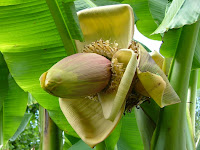Agriculture | Banana | Banana is the common name for herbaceous plants of the genus Musa and for the fruit they produce. Bananas come in a variety of sizes and colors when ripe, including yellow, purple, and red.
Almost all modern edible parthenocarpic bananas come from the two wild species Musa acuminata and Musa balbisiana. The scientific names of bananas are Musa acuminata, Musa balbisiana or hybrids Musa acuminata × Musa balbisiana, depending on their genomic constitution. The old scientific names Musa sapientum and Musa paradisiaca are no longer used.
Banana is also used to describe Enset and Fe'i bananas, neither of which belong to the Musa genus. Enset bananas belong to the genus Ensete while the taxonomy of Fe'i-type cultivars is uncertain.
In popular culture and commerce, "banana" usually refers to soft, sweet "dessert" bananas. By contrast, Musa cultivars with firmer, starchier fruit are called plantains or "cooking bananas." The distinction is purely arbitrary and the terms 'plantain' and 'banana' are sometimes interchangeable depending on their usage.
They are native to tropical South and Southeast Asia, and are likely to have been first domesticated in Papua New Guinea. Today, they are cultivated throughout the tropics. They are grown in at least 107 countries, primarily for their fruit, and to a lesser extent to make fiber, banana wine and as ornamental plants.
The banana plant is the largest herbaceous flowering plant. The plants are normally tall and fairly sturdy and are often mistaken for trees, but their main or upright stem is actually a pseudostem that grows 6 to 7.6 metres (20 to 24.9 ft) tall, growing from a corm. Each pseudostem can produce a single bunch of bananas. After fruiting, the pseudostem dies, but offshoots may develop from the base of the plant. Many varieties of bananas are perennial.
Leaves are spirally arranged and may grow 2.7 metres (8.9 ft) long and 60 cm (2.0 ft) wide. They are easily torn by the wind, resulting in the familiar frond look.
Each pseudostem normally produces a single inflorescence, also known as the banana heart. (More are sometimes produced; an exceptional plant in the Philippines produced five.) The inflorescence contains many bracts (sometimes incorrectly called petals) between rows of flowers. The female flowers (which can develop into fruit) appear in rows further up the stem from the rows of male flowers. The ovary is inferior, meaning that the tiny petals and other flower parts appear at the tip of the ovary.
The banana fruits develop from the banana heart, in a large hanging cluster, made up of tiers (called hands), with up to 20 fruit to a tier. The hanging cluster is known as a bunch, comprising 3–20 tiers, or commercially as a "banana stem", and can weigh from 30–50 kilograms (66–110 lb). In common usage, bunch applies to part of a tier containing 3-10 adjacent fruits.
Individual banana fruits (commonly known as a banana or 'finger') average 125 grams (0.28 lb), of which approximately 75% is water and 25% dry matter. There is a protective outer layer (a peel or skin) with numerous long, thin strings (the phloem bundles), which run lengthwise between the skin and the edible inner portion. The inner part of the common yellow dessert variety splits easily lengthwise into three sections that correspond to the inner portions of the three carpels.
The fruit has been described as a "leathery berry". In cultivated varieties, the seeds are diminished nearly to non-existence; their remnants are tiny black specks in the interior of the fruit. Bananas grow pointing up, not hanging down.
Bananas are naturally slightly radioactive, more so than most other fruits, because of their high potassium content, and the small amounts of the isotope potassium-40 found in naturally occurring potassium. Proponents of nuclear power sometimes refer to the banana equivalent dose of radiation to support their arguments. - Agriculture
Tags: banana stock photos, banana insurance, banana travel insurance, banana vpn, pomona banana plug, banana stock, banana leaf vancouver, banana allergy, quote banana insurance, banana flavored coffee, banana rum, banana travel, banana shpeel review, banana protein shake, banana calorie count, monkey want banana, banana oatmeal muffins, fried banana recipe, banana protein, banana allergy symptoms, fried banana





No comments:
Post a Comment